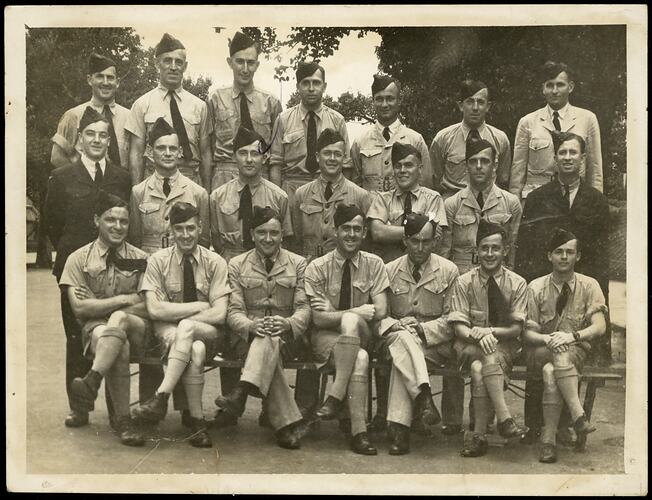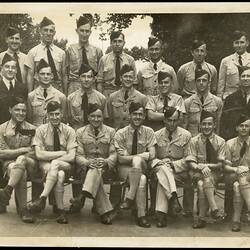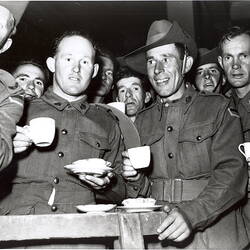During World War II, the Royal Exhibition Building (then called the Exhibition Building) in Melbourne was occupied by the RAAF and the WAAAF - mostly non-crew aircraftmen and aircraftwomen, trainers, medical personnel and administrators. One of the RAAF personnel stationed at the Exhibition Building was R.D. (Dick) Thompson. Decades later, Dick remembered his time at the Exhibition Building in an interview held in Museums Victoria's collection (HT 9603). He has been identified as Richard Desmond Thompson (service no. 23965). Born in 1922, he enlisted on 30 December 1940 and was discharged on 13 May 1946, when he was a Sergeant at the 3 Personnel Depot (Brisbane). Dates mentioned in his interview imply it was recorded between 1987 and 1991.
Dick explains that he was 'a young bloke who was primarily interested in radio'. He was posted to Melbourne in January 1941, and first slept on paliasses in an old building in Spencer Street - perhaps an old wool store. Around February or March he was moved to billets at the Exhibition Building, likely part of the first group to go there. They slept on the ground floor on paliasses and wire beds, next to the wall of the acquarium, and could hear seals at night. The kitchen and servery were also near the acquarium.
Their normal day started about 6.30-7.00am, with a parade in overalls on the south side of the building, near the fountain: quick jumping, quick route march towards city, around a side street, then back into front of building. Neighbours objected to the shouting of the march!
Their showers were downstairs in the basement, and were freezing cold. After showers they would have breakfast, usually porridge, sausages and gravy, onions, mashed eggs, tea and milk. They then grabbed their books and marched down to 1STT (1 School of Technical Training). It was located at the AWA building, and at Melbourne Tech; Beecham's Building was also used at some stage.
For the first month Dick's course was 'all morse code and telegraphy', eight hours a day. They were trained by reserve army captain/lieutenant, who was considered elderly at 35-40, and an ex-PMG man. They would break for morning tea about 10, then receive tuition until about midday, then were marched back to Exhibition Building for lunch (which Dick calls 'dinner', as was common at the time). They had about 30-45 minutes, eating simialar food to the breakfast offering, giving Dick time to write letters home before they marched back to the 1STT. In the afternoon they did morse code until about 4pm, paraded again, had 'a bit of break' for afternoon tea in the on-site canteen, then marched back to the Exhibition Building. They then had time to themselves - to shower, tidy, eat, and sometimes go out, although they had to be back by 10 or 11pm.
The post office was located to the right of the side door of the Exhibition Building, on an outrigger platform, and was run by the Postal Service. Dick would send letters home each day.
There was 'a little hospital unit' inside the building, towards the mess near the acquarium. Dick later had to go in with 'a bit of eye trouble' during his second stay in the Exhibition Building. He remembers 'carrying beds' made of canvas and two wooden poles, one of which is 'down there in the museum still' that 'belonged to the ordinary carrying ambulance thing.'
Personnel posted to the Exhibition Building could ask to be billetted out to private homes instead of staying on-site, and extra payments were provided to cover additional costs. Dick was billetted at a home near South Melbourne beach with a friend named John Crowley. They ate well and swam each morning at Sth Melbourne. They had to be back in time for marching each day, however.
Dick returned to the Exhibition Building again about 1942-43 for a special course in VHS transmitter-receivers. His war-time service included time in northern Australia which coincided with bombing raids. He recalls Japanese planes coming in groups of three, and could see the bombs falling from the aircraft and the sunlight flashing on them. A Liberator and a hospital hut were hit. On 24 Oct 1942 Batchelor Airfield was bombed - 'I was right in the middle of that', Dick recalls. He had been doing day and night shifts on wireless telegraphy, and was on night shift, having a rest, when he got a call that an air raid had started on Darwin. Too late he heard the aircraft approach. They hastily put the lights out, but the aircraft 'were ready to drop'. He couldn't make it to air raid shelter, so lay on ground, and was splattered with mud, but was safe.
Dick was later posted to 3 WAG school at Maryborough and instructed wireless air gunners. He remained there for 15 months or so, then volunteered for active service again, which took him to the islands, New Guinea (Pinchhaven), then for one month to the Admiralty Islands. He then joined a mobile fighter control unit, went to Strathpine, Queensland, then went back to Borneo, so was in the Tarakan invasion (May-June 1945). Just prior to Christmas 1945 he returned to Australia, before being discharged from service in May 1946.
References
National Archives of Australia service records, THOMPSON RICHARD DESMOND, barcode 4564069.
More Information
-
Keywords
-
Authors
-
Article types



